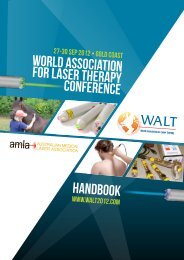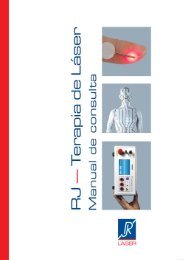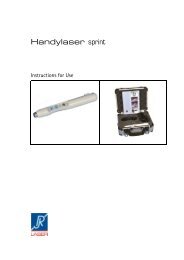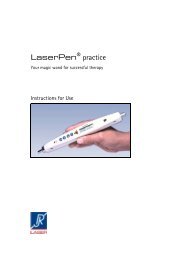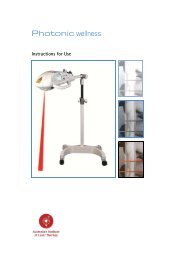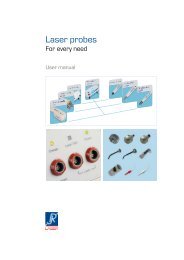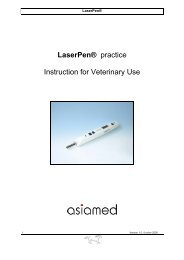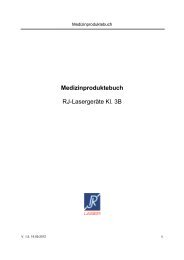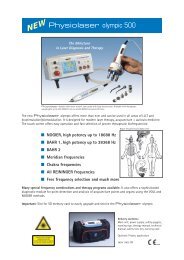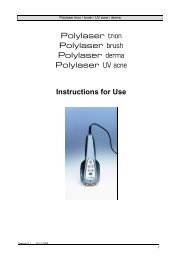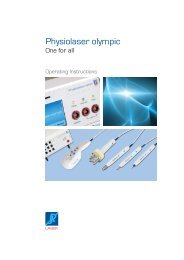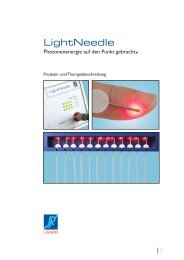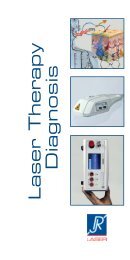LightNeedle - RJ Laser
LightNeedle - RJ Laser
LightNeedle - RJ Laser
Create successful ePaper yourself
Turn your PDF publications into a flip-book with our unique Google optimized e-Paper software.
18<br />
G. Litscher<br />
colleagues [4] did consider the SEF, nor did they<br />
investigate the effects of manual needle acupuncture<br />
and the effects of<strong>Laser</strong>needle@ acupuncture.<br />
We have shown in this study that awake volunteers<br />
subjected to acupressure at Yintang can have<br />
similar BIS and SEF values to anaesthetized patients.<br />
While it is unlikely that a patient will receive acupressure<br />
or acupuncture during surgery, the question<br />
as to what causes BIS readings below 50 in awake<br />
subjects remains. It is unlikely to be a placebo effect<br />
as we have shown in several test measurements usin~<br />
placebo points that BIS is not affected by <strong>Laser</strong>needle<br />
stimulation per se. In the present study there were<br />
small statistically significant but not clinically important<br />
changes with needle acupuncture, <strong>Laser</strong>needle@<br />
acupuncture and acupressure at control point. These<br />
findings also help confirm that the BIS and SEF<br />
reductions induced by acupressure at Yintang are<br />
not a placebo effect. Reduced electromyographic<br />
levels could be partially responsible [21]. At the<br />
moment it is unclear to what degree system algorithms<br />
contribute to such findings. BIS is certainly<br />
affected by electrical activity nearby, especially<br />
diathermy. Therefore, there could also be a possibility<br />
that local movement in the region of the recording<br />
electrode might be responsible for the EEG effects<br />
observed. These are apparently less during control<br />
point acupuncture than during Yintang acupressure,<br />
where pressure is applied to a point immediately<br />
adjacent to the Zipprep@ electrode. Further investigations<br />
are necessary to clarify these questions.<br />
In conclusion, we found in healthy awake volunteers<br />
that acupressure at Yintang results in statistically<br />
significant and clinically relevant reductions in<br />
BIS and SEF while needle acupuncture, <strong>Laser</strong>needle@<br />
acupuncture and acupressure at a control point result<br />
in statistically significant but clinically unimportant<br />
reductions. Although the validity of BIS in anaesthesia<br />
is higher than that of SEF, BIS too has to be<br />
interpreted very carefully as our results show. Our<br />
results also highlight the EEG similarities of acupressure<br />
induced sedation and anaesthesia.<br />
Acknowledgements<br />
The author would like to express his thanks to Dr Lu<br />
Wang, Mag. Petra Petz and Evamaria Huber (Department<br />
of Biomedical Engineering and Research in<br />
Anesthesia and Intensive Care, University of Graz)<br />
for their valuable help.<br />
References<br />
Litscher G, Schwarz G. Noninvasive bioelectrical neuromonitoring<br />
in anaesthesia and critical care. Bur J Anaesthesiol<br />
2001; 18: 785-788.<br />
2. Litschet G. Editotial. The future of neuromonitoring.<br />
Internet J Neuromonitoring 2000; 1(1): http:/ /www.ispub.com/<br />
ostia/ index. php ?xmlF ilePath = journals/ i j nm/voll n 1/<br />
editorial2.xml<br />
3. Rampil IJ. A primer for EEG signal processing in anesthesia.<br />
Anesthesiology 1998; 89: 980-1002.<br />
4. Fassoulaki A, Paraskeva A, Patris K, Pourgiezi T,<br />
Kostopanagiotou G. Pressure applied on the extra 1<br />
acupuncture point reduces bispectral index values and<br />
stress in volunteers. Anesth Analg 2003; 96: 885-889.<br />
5. Stux G, Pomeranz B. Basics of Acupuncture. Berlin, Germany:<br />
Springer, 1998.<br />
6. Litscher G, Schikora D. Cerebral vascular effects of noninvasive<br />
laserneedles measured by transorbital and transtemporal<br />
Doppler sonography. <strong>Laser</strong> Med Sci 2002; 17:<br />
289-295.<br />
7. Litscher G, Schikora D. Near-infrared spectroscopy for<br />
objectifying cerebral effects of needle and laserneedle<br />
acupuncture. Spectroscopy 2002; 16: 335-342.<br />
8. Sebel PS, Lang E, Rampil IJ, et al. A multicenter study of<br />
bispectral electroencephalogram analysis for monitoring<br />
anesthetic effect. Anesth Analg 1997; 84: 891-899.<br />
9. LiuJ, Singh H, White PF. Electroencephalographic bispectral<br />
index correlates with intraoperative recall and depth of<br />
propofol-induced sedation. Anesth Analg 1997; 84: 185-189.<br />
10. HeckM, Kurnie B, BoldtJ, LangJ, Lehmann A, Saggau W.<br />
Electroencephalogram bispectral index predicts hemodynamic<br />
and arousal reactions during induction of anesthesia<br />
in patients undergoing cardiac surgery.J Cardiothorac Vasc<br />
Anesth 2000; 14: 693-697.<br />
11. Chan MTV, Gin T. What does the bispectral EEG index<br />
monitor? Eur J Anaesthesiol2000; 17: 146-148.<br />
12. Greif R, Laciny S, Mokhtarani M, et al. Transcutaneous<br />
electrical stimulation of an auricular acupuncture point<br />
decreases anesthetic requirement. Anesthesiology 2002; 96:<br />
306-312.<br />
13. Tsay SL, Chen ML. Acupressure and quality of sleep in<br />
patients with end-stage renal disease -a randomized control<br />
trial. Int J Nurs Stud 2003; 40: 1-7.<br />
14. Felhendler D, Lisander B. Pressure on acupoints decreases<br />
postoperative pain. ClinJ Pain 1996; 12: 326-329.<br />
15. Boehler M, Mitterschiffthaler G, Schlager A. Korean hand<br />
acupressure reduces postoperative nausea and vomiting after<br />
gynecologicallaparoscopic surgery. Anesth Analg 2002; 94:<br />
872-875.<br />
16. Eizember FL, Tomaszewski CA, Kerns WP. Acupressure<br />
for prevention of emesis in patients receiving activated<br />
charcoal.J Toxicol-Clin Toxicol2002; 40: 775-780.<br />
17. Cho ZH, Wong EK, Fallon JH. Neuro-Acupuncture. Los<br />
Angeles, USA: Q-Puncture, 2001.<br />
18. Litscher G, Cho ZH, eds. Computer Controlled Acupuncture@.<br />
Berlin, Germany: Pabst Science Publishers, 2000.<br />
19. Litscher G. High-Tech Akupunktur@. Berlin, Germany: Pabst<br />
Science Publishers, 2001.<br />
20. Hui KKS, Liu J, Makris N, et al. Acupuncture modulates<br />
the limbic system and subcortical gray structures of the<br />
human brain: evidence from fMRI studies in normal subjects.<br />
Hum Brain Mapp 2000; 9: 13-25.<br />
21. Bruhn J, Bouillon TW, Shafer SL. Electromyographic<br />
activiry falsely elevates the bispectral index. Anesthesiology<br />
2000; 92: 1485-1487.



